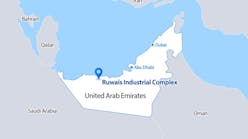SABIC, ExxonMobil form JV for USGC petrochemical complex
Robert Brelsford
Downstream Technology Editor
Saudi Arabian Basic Industries Corp. (SABIC) and ExxonMobil Chemical Co. have created a joint venture to advance development of their Gulf Coast Growth Ventures (GCGV) project, a 1.8 million-tonne/year ethane cracker currently planned for construction in San Patricio County, Tex. (OGJ Online, July 25, 2016).
SABIC and ExxonMobil Chemical have created a joint venture to advance development of their Gulf Coast Growth Ventures project, a 1.8 million-tpy ethane cracker currently planned for construction in San Patricio County, Tex. Artist rendering from GCGV.
Construction of the project—which will also include a monoethylene glycol unit and two polyethylene units—is pending completion of the environmental permitting process, the companies said.
Scheduled for startup in a 2021-22 timeframe, the proposed multibillion project is one of 11 proposed projects included as part of ExxonMobil’s 10-year, $20-billion Growing the Gulf expansion initiative announced in early 2017 (OGJ Online, Mar. 9, 2017).
Announcement of the GCGV JV follows the companies’ April 2017 selection of the San Patricio County site, which will allow ExxonMobil and SABIC to take advantage of the region’s existing infrastructure to capture competitive pricing for US natural gas feedstock as well as access to rising demand for ethylene-based products in overseas export markets (OGJ Online, Apr. 19, 2017).
Last year, ExxonMobil and SABIC, through Amec Foster Wheeler PLC (now part of John Wood Group PLC)—which serves as GCGV’s main engineering, procurement, and construction contractor—let a contract to Bay Ltd., Corpus Christi, to handle main civil and site maintenance work at the proposed project site, the companies said on Aug. 30, 2017.
Project technology
While specific details regard GCGV’s technology providers have yet to be officially disclosed, ExxonMobil and SABIC said they are investing millions of dollars in environmental controls at site, according to project documents.
Specifically, the companies will take two key measures to reduce and control NOx emissions, including low-NOx burners and selective catalytic reduction, while flares, vapor oxidizers, and filters will be used to reduce output of volatile organic compounds and particulate matter.
Further actions taken by the complex to protect the environment and minimize on and off-site safety risks will include:
• The use bleach (instead of chlorine) in the cooling towers to maintain high water quality for processing activities.
• No on-site storage of ethylene oxide, a reactive chemical formed in the production of ethylene glycol. Ethylene oxide instead will be converted directly into ethylene glycol with no intermediate storage.
• Recycling of final hydrocarbons residual into fuel for boilers to reduce natural gas consumption and reduce emissions.



